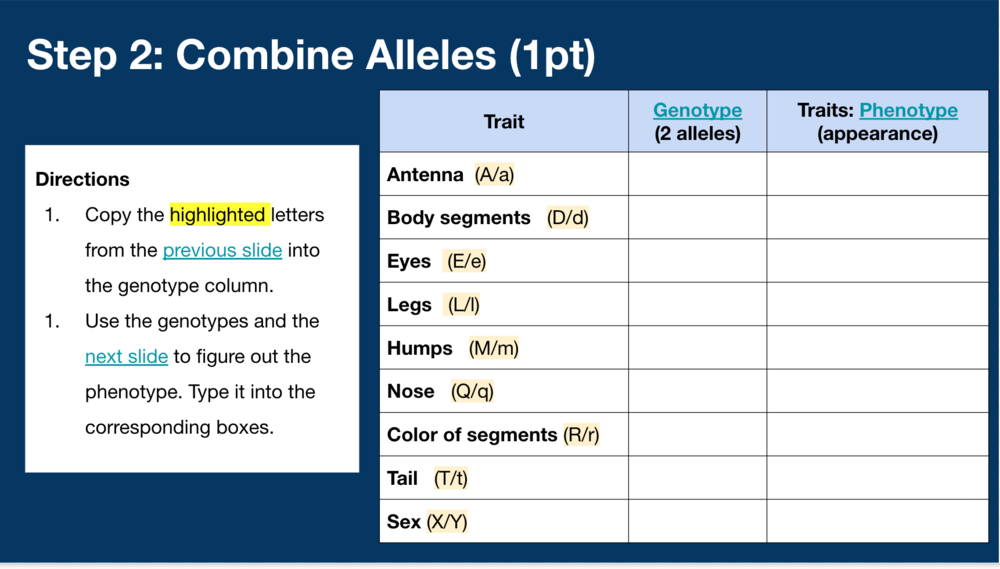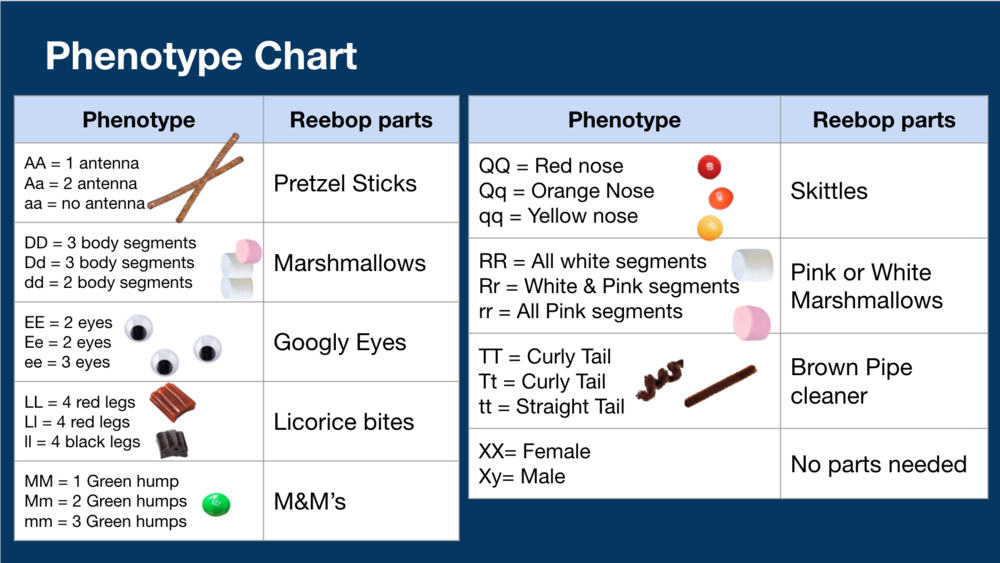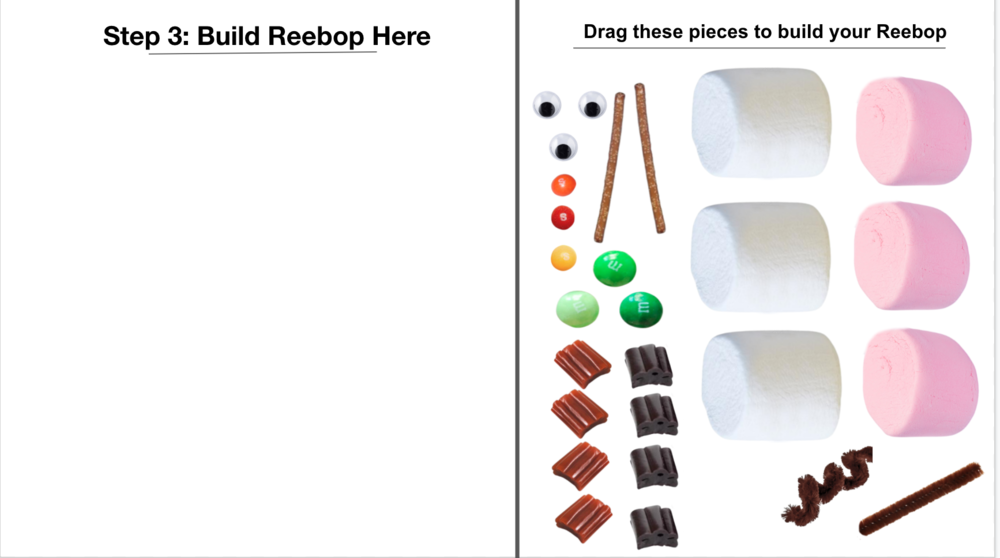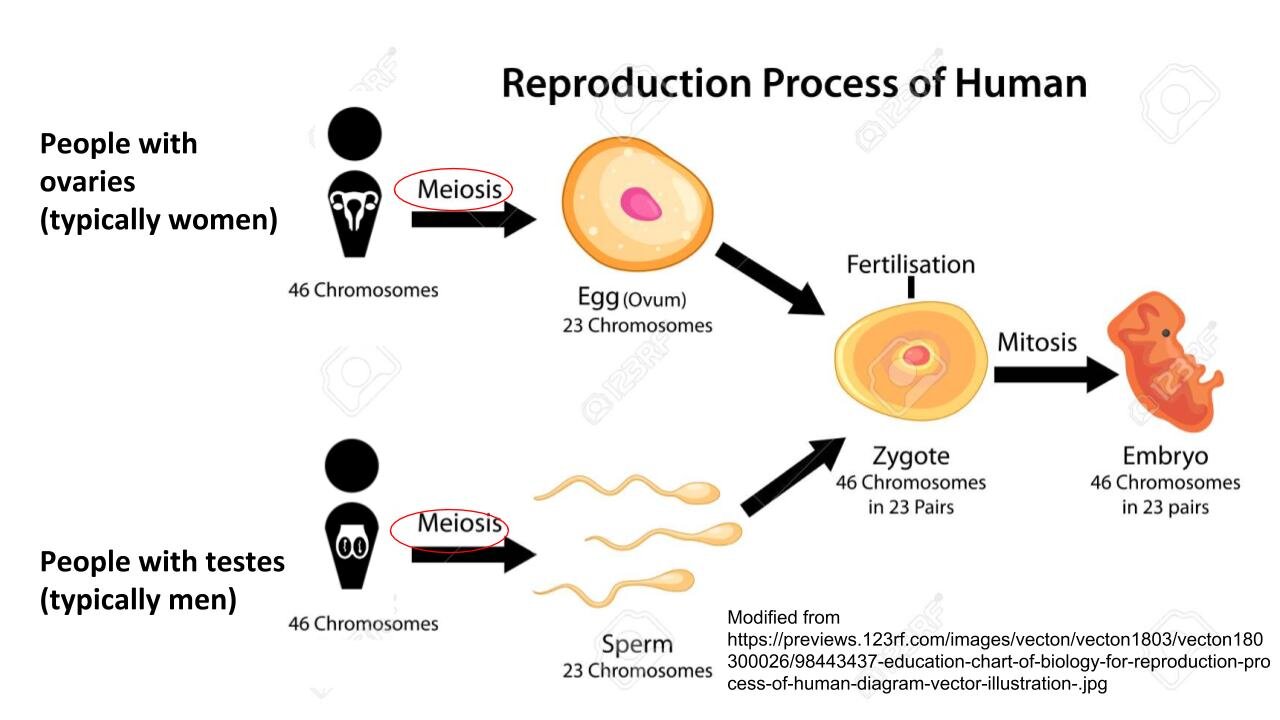This interactive from LabXchange has students scroll, click, and learn about meiosis in the context of reproduction. It uses language that is precise and inclusive of diverse human families, while also teaching the concept broadly enough to apply to other living things.
Reebops Nursery (gender-inclusive Genetics of independent assortment)
Gender-inclusive simulation of independent assortment for a genetics or evolution lesson. Adapted from slides created by Laura Funk (staff profile page) by modifying “mom” to egg-giver and “dad” to sperm-giver. Can also serve as model for discussion about mutations, epigenetics, evolution, chromosomes, alleles, nondisjunction. See also Teach.Genetics.Utah.edu's paper-based activities. See steps below and the questions for the assessment at the end. (Originally published here in 3/17/21.)
NGSS Works towards HS-LS3-1. Follow up with meiosis and HS-LS3-2.
Step 1: Flip a coin and highlight the capital or lowercase letter for that row.
Step 2: Combine the results from Step 1 to create a genotype (two letters).
Step 3: Use the third slide to decode the phenotype.
Step 4: Build the reebop based on the phenotype.
Assessment: Answer the questions in the Google Form.
0. Attach completed Reebops Nursery from your Drive.
1. Name your Reebop
2. What do you think each letter represents in the model?
3. What do you think combining the letters represents in the model?
4. All models are wrong. Some models are useful. What are some things missing from this model? List as many as you can think of.
5. Gametes (egg & sperm cells) contain 1 pair of chromosomes (n = haploid), the other body cells contain 2 pairs of chromosomes (2n=diploid). Is your baby reebop haploid or diploid?
Sex Determination and Non-disjunction Lesson by Sabrina Kayed
This highly accessible lesson was designed by Sabrina Kayed for Grade 11 Biology. The lesson is designed to move students’ understanding of biological sex beyond the simplistic binary model and introduce them to the idea of sex as a spectrum.
The macho sperm myth: Article by Robert D. Martin
Image source: LetsTalkSex.net
“Human fertilisation is a gigantic lottery with 250 million tickets: for healthy sperm, it is the luck of the draw.”
In this popular science article, Martin debunks a series of myths and double standards in human reproduction, including the pervasive, heteronormative belief that sperm cells "race" to reach an egg.
Gynandromorph Animals - BBC Earth article
This BBC Earth article explores the rare phenomenon of bilateral gynandromorphs, or animals which develop different physical sex characteristics on their left and right side. This occurs when a cycle of meiosis yields multiple viable eggs rather than one egg and three polar bodies to be discarded. When two eggs are fertilized by sperm, mosaicism can occur in the sex chromosomes.
When introducing students to the article, the teacher should be sure to note that overgeneralizing language is briefly used to describe humans (“In humans, men have an X and a Y chromosome, while women have two X chromosomes.”) However, the article can still have value in demonstrating the nonbinary nature of biological sex and the scientific processes by which evidence is gathered to support this.
A Reddit post shows a gynandromorph lobster found in the wild:
Diagram of Human Reproductive Process
Early in my teaching career I modified an existing diagram to create this image which shows how meiosis in testes and ovaries functions to complete the human life cycle. I could not in good conscience use existing diagrams where the two rows were labeled “Mother” and “Father”, “Woman” and “Man”, in text colored pink and blue, etc.. I needed something that precisely communicated the structures and processes involved, in a way that was simple for my students. Reflecting back, the phrases in parentheses may or may not be necessary depending on the audience. - Sam
The Egg and the Sperm: How Science Has Constructed a Romance Based on Stereotypical Male-Female Roles
The false romance of egg and sperm
In this article, anthropologist Emily Martin analyzes the metaphors that are used to teach reproduction and makes the claim that these metaphors reflect the socially constructed definitions of male and female.
Martin highlights modern research that dispels stereotypes of the sperm as being more aggressive, remarkable, and valuable than the egg. She advises scientists and educators to be aware of biases in the metaphors we use to describe human sex cells.
Activity: Nondisjunction and Intersex Traits
Description
In this activity, students pick up the nuts and bolts of nondisjunction by playing the Meiosis Game created by Sara Freeman and Matt Gilbert. Students simulate two scenarios of nondisjunction and record information about the intersex traits that arise. Students learn that while 46,XX and 46,XY are the most common human karyotypes, there are many other viable and naturally occurring variations. Then students evaluate the merits and limitations of the model.
Student Work Samples
Student Worksheet
Resource roundup: etymology, intersex traits, centering indigenous voices [Oct]
Hello, educators!
First off, a warm welcome to everyone who has recently joined our list. We're glad you are here! If you are interested in joining our interactive listserv to ask and answer questions from other educators, follow this link to sign up.
This month's newsletter highlights some more resources that you might find useful in your classroom.
Etymology stems - This awesome guide set up by Sam Long connects the etymology of words in science to terms common in the LGBTQIA+ community. From Sam: "This year my students are very interested in word origins and why things are named the way they are. I made this partial list of root words that occur in both LGBTQIA issues and science. It is a tool to help science teachers integrate gender-inclusive themes into their teaching. It's a pretty low-lift way to blend gender diversity into a science class. Please share your thoughts and additions!" Feel free to contact him with feedback and ideas - Sam.Long.MT@gmail.com.
October 26th was Intersex Awareness Day, celebrated in honor of the first known public demonstration by intersex advocates against nonconsensual genital surgeries in 1996. Read more about the history and impact of this day at InterACT and GLAAD, or read 9 ways intersex youth want to be supported by grown-ups to better-support intersex youth in schools.
Meiosis and Intersex Traits - Teaching meiosis and/or intersex traits at a high school or college level? Matt Gilbert's Sex Chromosome Meiosis Game explores the origins of some intersex traits in a way that is clear and interactive. This can also be a good way for educators to review processes that occur during meiosis in preparation for teaching intersex traits.
Two-Spirit Identity and centering Indigenous voices - Thanksgiving is coming up in the U.S., and there are lots of great resources about centering racial justice and indigenous rights in discussions of Thanksgiving. Some folks might not know that there are many examples of gender diversity being honored and respected in North American indigenous cultures. Though the terms and roles in different cultures vary, the term Two-Spirit became a universal term for gender diverse Indigenous North American people in the 1990s. Read more about the history the term Two-Spirit at the Indian Health Service or Indian Country Today, or watch a video about Two-Spirit and indigenous identity at them. magazine. You can also find books for your age group centering two-spirit stories - consider 47,000 Beads by Koja Adeyoha for young readers or Love Beyond Body, Space and Time for a young adult audience.
Conferences - If you're in the Denver area, look for Sam & Lewis at the Colorado Science Conference on Friday, November 8th.
Take care, all, and happy Halloween!
Lewis & Sam














